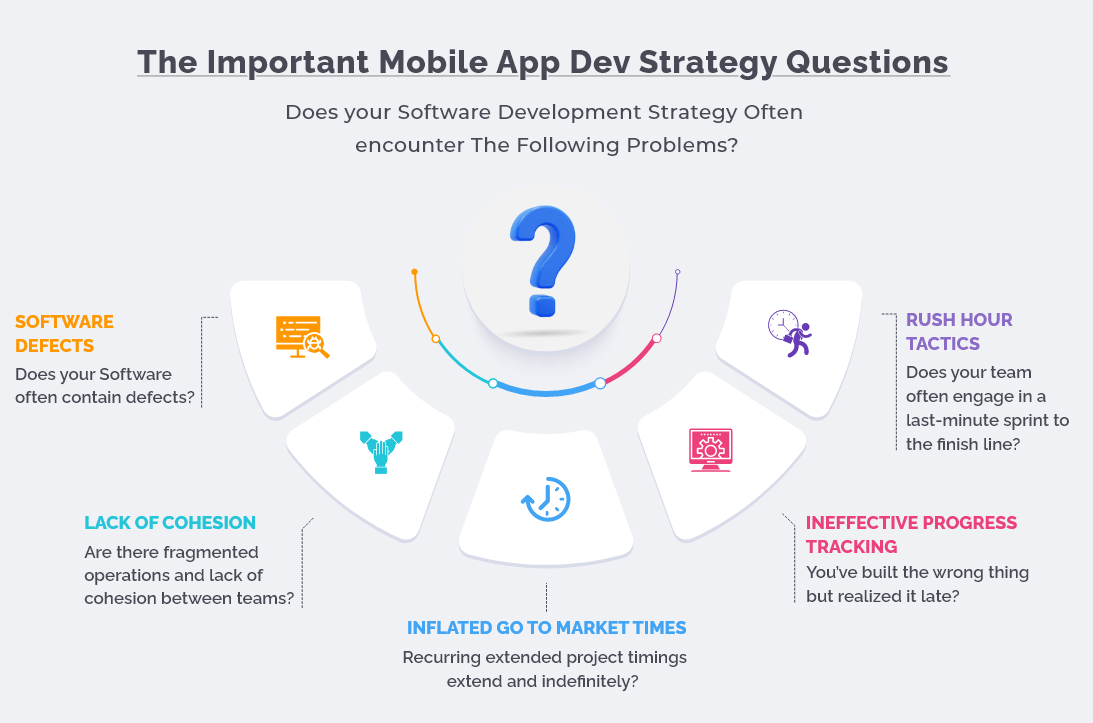"No one is going to buy a big phone? Guess who surprised themselves and changed their minds" - Samsung.
The computing performance of mobile phones today easily rivals that of laptops or desktops. As a result, most Original Equipment Manufacturers (OEMs), including the infamously apprehensive Apple Inc., have jumped aboard the 'large mobile devices' train. The large screen size, onboard storage capacity, and immense processing power of the current mobile devices, offered at a significantly lower cost, are pushing the envelope of mobile application development services as we know them.
All business leaders who are spearheading a mobile app development company must ask themselves a very important question,
"Does my mobile app design and development strategy still pack a punch?"
How You Should Evaluate Your Mobile App Development Strategy?
Recognizing the Problem
The efficiency of mobile app development companies often gets watered down due to the pressure to adhere to stringent go-to market times. As a result, many inherent flaws fly under the quality radar and make their way into the live environment, infuriating end-users with poor usability.
Are your mobile applications up to the mark? Here are a few introspective questions you must ask yourself to know where you stand.

Understanding Causality: The Reasons Behind the Common Mobile App Development Pitfalls
#1 Prevalent Software Defects
According to a survey by Techbeacon the reputed information hub for DevOps, IT and security app professionals, 61% of mobile app users expect an app on their phone to start within four seconds. Any failure to meet these expectations causes significant damage to the brand representing the app. The underlying causes for recurring app glitches are as follows:
Imperfections in Testing: Apps that perform well on simulators during testing show significant variation when operating in a live environment. Overlooking this variance in app performance consideration often leads to imperfect testing protocols that ultimately allow flaws to fly under the radar.
Software Optimization: All the mobile apps on the end user’s handset are competing for hardware resources such as memory. Therefore, it is imperative for mobile application development service providers to consider app memory usage in intricate detail to ensure expected performance viability on the operating system.
Network Alignment: Mobile apps rely on telecommunication networks to access data and specific services that keep them operational. Despite the advent of fast mobile networks such as 5G, their older contemporaries such as 3G and 2G still continue to be in use in many countries. It is possible for mobile apps attuned to high-speed networks to falter in the availability of only lower network speed vastly hampering the user experience.
#2 Lack of Cohesion
For the mobile application development process to function like a well-oiled machine the stakeholders, developers and project managers must be up to speed on all its facets such as wireframe design, UI/UX prototyping, code base generation, cloud migration and testing. Efficiency in collaboration unifies the collective of app development which ensures the process on point with the milestones agreed upon. If there is a lack of cohesion among the development team members and the stakeholder, it is usually due to one or all of the following reasons:
Intractability of the Design and Development Team: Despite the best efforts of the management the design and development teams often remain siloed. The main reason behind this schism remains the tendency of developers to think technically and talk in specifics while the designers think creatively and speak in generalities.
Discordant Communication Channels: Designers and developers prefer to have job specific communication channels to advance the mobile app development process. This makes the transposition of design into working functionality difficult.
Unclear Individual Goals: A synergized team is the one which is capable of running in ‘auto-pilot’ mode striving to provide accountability for its activities. Most mobile app development companies focus less on easing the friction between dependent teams by finalizing projects goals such as design completion and code prototyping at an individual level that increases the friction between design, development and project management teams and the stakeholders.
#3 Inflated Go to Market Times
Mobile apps have evolved into important strategic business tools capable of imparting significant traction for businesses from an ROI perspective. Hence, most mobile apps are strictly bound by a release schedule that is governed by the business goals of the mobile app development company's client. The failure to meet these deadlines can be attributed to.
Lack of Product Discovery and Definition: Product discovery enables a mobile app development company to understand how well an app would align with the end-user needs and expectations. It is a crucial step of the requirement gathering stage that is not always followed, leading to multiple requirement changes during the development process. This causes an extension of go-to-market time.
Improper Product Release Strategy: Considerations such as the number of platforms to support during launch, level of animations in the app, transitions and the product or service the app supports determines a product release strategy. Due to a mismatch in the synergy between designers, developers and the stakeholders, app release data often overshoot causing significant delay in go to market times.
#4 Ineffective Progress tracking
With the progress of completion closely associated with discordant communication channels included in point #2, most mobile app development service providers usually bank on tolls such as Trello and Jira to track progress. Despite their best efforts to stay on top of the progress, most teams get sidetracked by the common, '90 % done' syndrome. The two main reasons behind this are:
Lack of Objectivity: The measurements involved in the completion of a mobile app development project must be observable and verifiable. Often, a lack of objective progress measurements fails to inform project managers adequately about the stages of completion of various app components such as UI, payment integration etc., especially when third party vendors are involved in the project.
Work Units and Activities Complete: Every project manager plans the number of components of the app to be completed by a stipulated date. The percentage of completion of components are the work units completed and the activities associated with completing app components constitute activities. Poorly implemented work unit tracking for activities such as design, development, code testing, system testing, data migration, etc. lead to inefficient progress tracking.
#5 Rush Hour Tactics
A desperate sprint to the finish line with many work units and activities pending is risky. Yet, many mobile application development teams seem to be unable to avoid the last-minute rush. The reasons behind the frantic push at the 11th hour can be attributed to:
Lack of Stakeholder Synergy: Clients often change their minds, and stakeholders are left to deal with escalating mobile app development costs caused by an increase in the time of development. The changing requirements unsettling the synergy between the stakeholders.
Unfamiliarity with Technologies: All mobile app development frameworks contain unique possibilities that enable mobile app development companies to design and develop specific features in a mobile app. Often, app development companies make compromises with functionality, pursuing close approximations of what they can achieve with their knowledge of frameworks they are used to instead of the actual vision of the client. The compromise arises from their unfamiliarity with a certain framework and approaching deadlines.
If your mobile app development strategy is full of the problems discussed in the section above, as a decision maker, its up to you to pick out the thorns. It will be meticulous and laborious, but it also contains high rewards.
When regrouping with your code wizards for improvements, the following are some essential points for you to consider during the rest of the year.
What Are the Top 5 Considerations for Your Mobile app Development Strategy in 2022?
1: Technology Trends: 5G, Augmented Reality (AR), Virtual Reality (VR), IoT, mobile wallets, chatbots, handset assistants, etc, are some of the many mobile app technology trends of the future beckoning the interest of mobile app developers. Besides coping with their growth it is imperative for your app development team to be able to leverage their benefits and distil them for your end users to consume.
The following are your areas of focus in technology development for 2022.
- Focus on Progressive Web App Development by adopting.
- Come to grips with IoT driven app development that works flawlessy with wireless hardware.
- Gain expertise in the development of VR apps since they will be powerful avenue for digital marketing of products and services in the future.
- Focus on data analytics to enable user behavioural data capture in a highly competitive marketplace.
Also Read: Winning the Mobile App Development Battle
2: UI and UX (UI/UX) Interaction Design (IxD): The concept of IxD breaks down the waypoints of the UX journey to granular considerations, or interactions, to be precise. The considerations for interactions allows your developers to plan the UX journey down to the bone with steadfast accuracy.
The following are the points of focus in interaction design for your mobile app development team:
- Create waypoints for animation, transitions, navigation steps, design, etc.
- Evaluate beauty vs usefulness and make rigorous data driven choices.
- Supply the right information at the right time at the right space in the app.
- Declutter the UI and supply bite sized information with navigation controls of the app.
- Self-evident Navigation.
- Provide ample sized tap-targets in the UI.
- Utilize loading indicators or buffer progress icons to show what's happening in the background on the screen.
Also Read: Establishing a memorable software experience through UI/UX
3: Security Governance: Your development team always has access to sensitive corporate information at all times. Consider them as the potential chinks in your data security armor. You need a sustainable security governance strategy to monitor development activity and the level of access each one of your project managers and their subordinates has at any given stage.
Here are the essentials to consider:
- Multi-factor authentication to heighten app security and provide alternate log in fucntionality to user.
- Develop protocols for remote wipe and process document control.
- Test and checking the security vulnerabilities without running the code or app through static test analysis.
- Thoroughly test app behavior as an end-user through dynamic test analysis.
- Penetration testing: Scout for vulnerabilities, such as network, server, web apps, mobile devices, and other endpoints through penetration testing.
Also Read: An Overview of API security
4: Managing Feature Updates: The mobile app development space is highly dynamic in nature. Operating systems are constantly being improved and new devices are being released, which means that the development tools and platforms required to create an app are also constantly evolving. Mobile app development companies have no choice but to rely on app updates to stay up to date with the changing technology landscape and ensure that their customers have the best possible experience when using the app.
- Choose and stick to a time-based strategy that ranges from monthly to quarterly for mobile app updates.
- Leverage event-based app updates such as seasonal sales and offers, wisely.
- Focus the most on a feedback-based mobile app update strategy where your app gives its users exactly what they seek.
- Stay in sync with current user trends and release app updates that are specifically targeted towards enhancing UI.
- Synchronize your app updating strategy with your marketing campaigns and product marketing goals.
Also Read: Optimize Your Offerings For Mobile
Explore Partnership Advantages in Mobile Application Development Services
A meaningful partnership could be the start of a new relationship that may help you iron out inherent problems with your mobile application development process. It can save you plenty of time that is usually spent on reworks and correcting glitches with the finished app.
Get in touch with our enterprise mobility experts to garner new momentum in your mobile app development strategy for 2022!
Reach out to us at info@nalashaa.com for more details.

